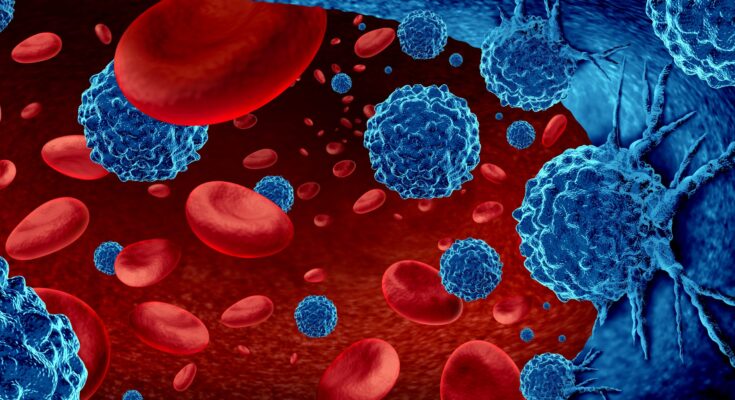Lymphoma Treatment: Lymphoma, a type of cancer that originates in the lymphatic system, is a critical health condition that affects thousands of individuals worldwide.
The lymphatic system, an integral part of the immune system, comprises lymph nodes, the spleen, thymus, and bone marrow.
Lymphoma specifically targets the lymphocytes, a type of white blood cell that plays a vital role in defending the body against infections.
Understanding Lymphoma
Lymphoma is a type of cancer that originates in the lymphatic system, which is part of the body’s immune system. Understanding the different types of lymphoma, as well as their symptoms and epidemiology, is crucial for early diagnosis and effective treatment. Here’s a closer look at the types of lymphoma, key statistics, and symptoms to watch for.
Types of Lymphoma
Lymphoma is primarily categorized into two main types:
- Hodgkin Lymphoma (HL): Characterized by the presence of Reed-Sternberg cells, Hodgkin Lymphoma is relatively rare and typically affects young adults and individuals over 55 years old.
- Non-Hodgkin Lymphoma (NHL): More common than Hodgkin Lymphoma, NHL encompasses a diverse group of cancers that originate from lymphocytes. This type can vary significantly in its severity, from indolent (slow-growing) to highly aggressive forms.
Each type of lymphoma has several subtypes, highlighting the complexity and varied nature of the disease.
Statistics and Epidemiology
Lymphoma accounts for about 4% of all cancers diagnosed globally, with Non-Hodgkin Lymphoma being more prevalent than Hodgkin Lymphoma. Here are some key statistics:
- Approximately 85-90% of lymphomas diagnosed are Non-Hodgkin Lymphoma.
- In the United States, the estimated new cases of lymphoma (both HL and NHL) for the current year are over 80,000.
- Lymphoma has a relatively high survival rate compared to other cancers, with five-year survival rates varying based on the type and stage at diagnosis.
Key Symptoms to Watch For
Identifying lymphoma early can significantly improve treatment outcomes. Key symptoms include:
- Swollen lymph nodes: Often one of the first signs, noticeable as painless swelling in the neck, armpits, or groin.
- Persistent fatigue: Unexplained, severe tiredness that does not improve with rest.
- Night sweats: Heavy sweating during the night that can’t be attributed to the room temperature or other environmental factors.
- Unexplained weight loss: Losing a significant amount of weight without changes to diet or exercise habits.
- Fever: Persistent unexplained fever can be a sign of lymphoma as the body fights off cancerous cells.
For anyone concerned about these symptoms or lymphoma in general, a consultation with a healthcare provider is strongly advised. Early detection is crucial for better prognosis and treatment effectiveness.
Diagnosing Lymphoma
Diagnosing lymphoma, a type of cancer that affects the lymphatic system, is crucial for effective treatment and management. This section provides an overview of the initial steps to take if lymphoma is suspected, the common diagnostic tests and procedures used, and highlights emerging technologies that are enhancing lymphoma diagnosis.
Initial Steps and When to See a Doctor
If you suspect you may have lymphoma due to symptoms such as swollen lymph nodes, unexplained weight loss, fever, night sweats, or fatigue, it is important to take prompt action. The first step is to document your symptoms, noting their frequency, duration, and severity. This information is vital for your healthcare provider to make an accurate assessment.
You should see a doctor if:
- You have persistent, painless swelling of lymph nodes in your neck, armpits, or groin.
- You experience systemic symptoms like fever, weight loss, or night sweats.
- Symptoms persist beyond a few weeks or worsen over time.
Early consultation with a healthcare professional is key to early diagnosis, which can significantly improve treatment outcomes.
Common Diagnostic Tests and Procedures
The diagnosis of lymphoma typically involves a series of tests and procedures, including:
- Physical Examination: The doctor will check for swollen lymph nodes, liver, and spleen and discuss your medical history.
- Blood Tests: These can help rule out infections or detect certain abnormalities that might suggest lymphoma.
- Imaging Tests: Techniques like X-rays, CT scans, PET scans, and MRIs can be used to locate lymphoma tumors throughout the body.
- Biopsy: This is the definitive test for diagnosing lymphoma. A sample of tissue, usually from a lymph node, is removed and examined under a microscope by a pathologist.
- Bone Marrow Biopsy: To check whether lymphoma has spread to the bone marrow.
Each of these tests provides essential data that helps in forming a comprehensive understanding of the individual’s condition.
Emerging Technologies and Techniques in Lymphoma Diagnosis
Advancements in medical technology are improving the accuracy and speed of lymphoma diagnoses:
- Liquid Biopsy: This emerging technique involves detecting cancer cells or DNA from a simple blood sample, offering a non-invasive alternative to traditional biopsies.
- Genomic Sequencing: Advanced genomic tests can identify specific mutations in lymphoma cells, helping to tailor treatments to the genetic profile of the tumor.
- Artificial Intelligence (AI): AI and machine learning are being integrated into diagnostic processes to analyze data more quickly and accurately, potentially identifying patterns that may be missed by humans.
By understanding the initial steps to take when symptoms of lymphoma appear, being aware of the common diagnostic tests and procedures, and staying informed about emerging technologies, patients and healthcare providers can better manage this challenging condition.
Treatment Options for Lymphoma
Understanding the various treatment modalities and the factors that influence the choice of treatment can empower patients and caregivers in making informed decisions.
List of Treatment Modalities
- Chemotherapy: This is the primary treatment for most types of lymphoma. It involves using drugs to kill cancer cells or stop them from growing. Chemotherapy can be administered orally or intravenously and is often combined with other treatments.
- Radiation Therapy: Targeted radiation can be used to shrink tumors or eliminate cancer cells. It’s particularly useful in early-stage lymphoma or when the disease is localized to one area.
- Immunotherapy: Leveraging the body’s immune system to fight cancer, immunotherapy treatments use substances made by the body or in a laboratory to improve or restore immune system function.
- Targeted Therapy: These drugs target specific aspects of cancer cells, like proteins or genes that contribute to the cancer’s growth and survival. This treatment aims to help preserve healthy cells while attacking cancer cells.
- Stem Cell Transplant: In cases of high-risk or recurrent lymphoma, a stem cell transplant might be considered. This procedure involves replacing diseased bone marrow with healthy stem cells that can regenerate healthy blood cells.
- Surgery: Although less common, surgery can be used to remove an isolated lymph node or to relieve symptoms in specific cases.
Deciding on the Right Treatment Approach: Factors to Consider
When determining the most appropriate lymphoma treatment plan, several key factors must be taken into account:
- Type and Stage of Lymphoma: Different types and stages of lymphoma may respond better to certain treatments. For example, early-stage Hodgkin lymphoma might be treated differently than advanced non-Hodgkin lymphoma.
- Patient’s Overall Health: The patient’s age, overall health, and pre-existing conditions can influence what treatment options are feasible. Certain treatments might pose too high a risk for some patients.
- Potential Side Effects: Each treatment has potential side effects. Understanding these can help in deciding which treatment is more tolerable on an individual basis.
- Personal Preferences: Patient values and lifestyle considerations are important. For instance, some may prioritize treatments that have a shorter duration or fewer side effects.
- Consultation with Oncologists: Regular consultations with oncology specialists who understand the nuances of lymphoma are crucial. These professionals can provide detailed insights into the benefits and risks of each treatment option.
However, choosing the right treatment for lymphoma involves a comprehensive evaluation of these factors, supported by ongoing dialogue between patients and their healthcare teams.
Advanced Lymphoma Treatment
Lymphoma, a type of cancer that begins in cells of the lymph system, has seen significant advancements in treatment options that leverage the latest in medical science and technology. This section explores the cutting-edge approaches being adopted in the care and management of lymphoma.
The Role of Precision Medicine in Lymphoma Care
Precision medicine is revolutionizing the treatment of lymphoma by tailoring therapies to the unique genetic profile of both the patient and the tumor. This approach helps in identifying the most effective treatments based on a patient’s specific condition, thereby enhancing treatment efficacy and minimizing side effects. Key components include:
- Genetic Testing: Identifying genetic mutations in lymphoma cells to select targeted therapies.
- Personalized Treatment Plans: Customizing therapy regimens that best suit an individual’s genetic makeup and disease characteristics.
- Biomarker Development: Using biomarkers to monitor the progress of the disease and the effectiveness of the treatment.
Clinical Trials and New Frontiers in Treatment
Clinical trials are pivotal in the development of new lymphoma treatments. They provide essential data that can lead to regulatory approval of new therapies that are more effective or have fewer side effects than existing options. Highlights include:
- Innovative Drug Therapies: Trials for new drugs that specifically target lymphoma cells without harming normal cells.
- Immunotherapy Advances: Testing new ways to boost the immune system’s ability to fight cancer.
- Combination Therapies: Exploring the efficacy of combining various treatments to enhance patient outcomes.
Breakthroughs in Lymphoma Treatment Research
Research into lymphoma treatment has yielded several breakthroughs in recent years, significantly altering the landscape of cancer care. These breakthroughs include:
- CAR-T Cell Therapy: A revolutionary treatment that modifies a patient’s T-cells to better recognize and attack lymphoma cells.
- Checkpoint Inhibitors: Drugs that help the immune system recognize and destroy cancer cells more effectively.
- Molecularly Targeted Drugs: Medications designed to target specific abnormalities found in cancer cells, leading to more precise and less toxic treatments.
Each of these advancements not only promises better outcomes for patients but also exemplifies the dynamic, rapidly evolving nature of medical research in oncology. As these innovations continue to develop, they offer hope for more effective and personalized lymphoma care.
Managing Lymphoma
Side Effects and Management During Treatment
Treating lymphoma can involve various therapies such as chemotherapy, radiation, and immunotherapy, each associated with its own set of side effects. Common side effects include fatigue, nausea, hair loss, and increased susceptibility to infections. Effective management strategies are crucial for maintaining quality of life during treatment. Here are some tailored approaches:
- Fatigue Management: Engage in light exercise, maintain a regular sleep schedule, and allow yourself short rest periods throughout the day to combat fatigue.
- Nausea Control: Small, frequent meals and anti-nausea medications prescribed by your healthcare provider can help manage nausea.
- Infection Prevention: Avoid crowded places and individuals with infections. Practice good hygiene and consider wearing a mask to decrease infection risks.
- Emotional Support: Access counseling or support groups to help cope with the emotional stress of treatment.
Importance of Follow-Up Care and Monitoring
After completing lymphoma treatment, follow-up care is essential to monitor recovery and detect any signs of relapse early. Regular visits to a healthcare provider, typically involving physical exams, blood tests, and imaging studies, are critical. The schedule for follow-up visits can vary, but they are usually more frequent during the first few years after treatment. Here’s why consistent follow-up is crucial:
- Early Detection of Relapse: Regular monitoring helps in detecting relapse early, improving the chances of successful management.
- Management of Long-Term Side Effects: Some side effects of treatment can be long-lasting or delayed; follow-up care helps manage these effectively.
- Psychological Assessment: Ongoing psychological support can be provided during these visits to address any long-term emotional impact.
Lifestyle Adjustments and Supportive Care
Adjusting your lifestyle can significantly affect your well-being during and after lymphoma treatment. Consider these supportive care tips:
- Nutritional Support: A balanced diet rich in fruits, vegetables, and lean proteins can help strengthen your immune system and support tissue repair.
- Physical Activity: Regular physical activity adapted to your energy levels can help reduce fatigue and stress.
- Avoiding Tobacco and Alcohol: Reducing or eliminating tobacco and alcohol use can enhance your overall treatment outcomes.
- Stress Management: Techniques such as meditation, yoga, or hobbies can reduce stress and improve mental health.
However, managing lymphoma effectively involves a comprehensive approach that includes treatment side effect management, diligent follow-up care, and supportive lifestyle adjustments.
The Future of Lymphoma Treatment
Lymphoma treatment has seen significant advancements over the past decades, and the future promises even more innovative approaches. This article explores the upcoming trends in lymphoma treatment, underlines the importance of advocacy and ongoing research, and highlights potential future breakthroughs.
Upcoming Trends in Lymphoma Treatment Techniques
- Precision Medicine: Tailoring treatment based on individual genetic profiles is becoming more prevalent. This approach allows for more targeted therapies, reducing side effects and improving outcomes.
- Immunotherapy Enhancements: New forms of immunotherapy, such as CAR-T cell therapy, are continuously being developed. These treatments harness the power of the patient’s immune system to fight cancer more effectively.
- Integration of Digital Health: Wearable devices and mobile health apps are increasingly used to monitor patients’ health in real-time, allowing for adjustments in treatment plans promptly.
- Advanced Radiotherapy Techniques: Innovations like proton therapy provide more precise targeting of cancer cells, minimizing damage to surrounding healthy tissues and leading to better recovery rates.
The Importance of Advocacy and Ongoing Research
- Increased Funding: Advocacy helps secure funding for lymphoma research, which is crucial for developing new treatments and improving existing ones.
- Policy Change: Advocates play a key role in influencing health policy, improving access to care, and ensuring that new therapies are available to patients as soon as they are approved.
- Patient Support: Through advocacy, awareness is raised about lymphoma, and support networks are strengthened, providing emotional and practical support to patients and their families.
Potential Future Breakthroughs in Lymphoma Treatment
- Gene Editing: Techniques like CRISPR could revolutionize lymphoma treatment by directly modifying the genes involved in the disease, potentially leading to a cure.
- Nano-Medicine: The use of nanoparticles to deliver drugs directly to cancer cells is an area of intense research. This could increase the efficacy of chemotherapy while reducing its toxicity.
- Artificial Intelligence in Diagnosis and Treatment Planning: AI can analyze vast amounts of medical data to predict treatment outcomes, personalize therapy plans, and detect lymphoma at earlier, more treatable stages.
The future of lymphoma treatment is bright, with promising new technologies and an ever-deepening understanding of the disease. Advocacy and ongoing research are vital to ensure that these advancements continue to reach patients, improving survival rates and quality of life.
FAQs about Lymphoma Treatment
What is lymphoma?
Lymphoma is a type of cancer that originates in the lymphatic system, the disease-fighting network spread throughout your body. There are two main types: Hodgkin lymphoma and non-Hodgkin lymphoma, each affecting the body differently.
What are the common treatments for lymphoma?
Treatment for lymphoma typically includes chemotherapy, radiation therapy, targeted therapy, immunotherapy, and sometimes stem cell transplants. The specific approach depends on the type and stage of lymphoma, as well as the patient’s overall health.
How long does lymphoma treatment last?
The duration of lymphoma treatment can vary. It usually depends on the type and stage of lymphoma, the treatment plan, and how the patient responds to therapy. Treatments can range from several months to a couple of years.
Is lymphoma curable?
Many types of lymphoma are highly treatable, and even curable, with early detection and appropriate treatment. The prognosis depends on several factors including the lymphoma type, stage at diagnosis, patient’s age, and overall health.
What are the side effects of lymphoma treatment?
Side effects can vary depending on the type of treatment and may include nausea, fatigue, hair loss, and increased risk of infection. Long-term effects can also occur, which is why ongoing monitoring and supportive care are important.
Can lifestyle changes help during lymphoma treatment?
Maintaining a healthy lifestyle can help manage the side effects of treatment and support recovery. This includes eating a balanced diet, staying physically active, getting adequate rest, and avoiding tobacco and excessive alcohol use.
Should I seek a second opinion for lymphoma treatment?
Seeking a second opinion can be beneficial if you are unsure about your diagnosis or treatment plan. It can provide more information and help you feel more confident in your healthcare decisions.
Conclusion
In summary, the treatment of lymphoma involves a variety of approaches tailored to the specific type and stage of the disease. These treatments range from chemotherapy and radiation therapy to more targeted methods such as immunotherapy and stem cell transplants. Each strategy is designed to effectively manage the disease and improve the patient’s quality of life.
For patients and families dealing with lymphoma, staying informed about the latest treatment options and research is crucial. It empowers you to make educated decisions regarding care and supports active participation in the treatment process. Remember, knowledge is a powerful tool in the journey toward recovery.
If you or a loved one is battling lymphoma, we strongly encourage you to consult with healthcare providers who can guide you in creating a personalized care plan. These professionals are your best resource for understanding treatment options and finding the most effective strategies tailored to your specific condition. Take action today by speaking with your doctor about the best steps forward for your health and well-being.
References
For further reading on lymphoma treatment and to validate the information provided, consider exploring these reputable sources. These links offer comprehensive details and the latest research in the field of lymphoma treatment:
- American Cancer Society: This organization provides a detailed guide on the types of lymphoma, treatment options, and ongoing research. Read more about lymphoma treatment on the American Cancer Society’s website.
- Mayo Clinic: Known for its expertise in medical treatment and research, the Mayo Clinic offers extensive information on the diagnosis, treatment, and management of lymphoma. Visit Mayo Clinic’s lymphoma page.
- National Cancer Institute: As part of the U.S. National Institutes of Health, this site provides in-depth material on the nature of lymphoma, treatment protocols, and clinical trials. Explore the National Cancer Institute’s resources on lymphoma.
- Leukemia & Lymphoma Society: This society focuses specifically on blood cancers, offering up-to-date treatment information, support resources, and advocacy for lymphoma patients. Learn more from the Leukemia & Lymphoma Society.
Each of these resources is authoritative and offers reliable and current information that can help patients, caregivers, and medical professionals make informed decisions about lymphoma treatment.



